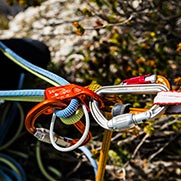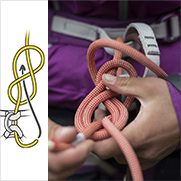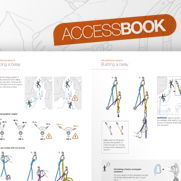Crevasse rescue no. 3: haul systems for crevasse rescue
Warnings
- Carefully read the Instructions for Use used in this technical advice before consulting the advice itself. You must have already read and understood the information in the Instructions for Use to be able to understand this supplementary information.
- Mastering these techniques requires specific training. Work with a professional to confirm your ability to perform these techniques safely and independently before attempting them unsupervised.
- We provide examples of techniques related to your activity. There may be others that we do not describe here.
Many types of haul systems exist; some are more suited to various situations than others.
Here are three classic haul systems that can be done independently with minimal equipment. As with all rescue situations, training and prior knowledge of the techniques to use, are the best guarantee of success.
Simple haul system
Theoretical efficiency: 3 to 1 (victim weight divided by 3)
Advantages: minimal equipment necessary. Rapid, simple installation. Easy transition to a higher-efficiency haul system.
Disadvantages: average efficiency.
Suitable situation: victim who is capable of helping with their own ascent by using the wall.
Lightweight victim who the rescuer can easily haul.
WARNING:
For the entire duration of hauling maneuvers, the rope between the anchor and the victim must remain taut to limit the risk of shock loading. If the victim is active, for example when crossing the lip, the slack rope must be continuously taken up.
Double Mariner
Theoretical efficiency: 7 to 1 (victim weight divided by 7).
Advantages: efficient hauling with reduced equipment.
Disadvantages: complex installation, training and memorization required. Requires a 5 m cord. A lot of rope to take up.
Suitable situation: victim unable to help, edge friction, heavy victim and lightweight rescuer...
WARNING:
For the entire duration of hauling maneuvers, the rope between the anchor and the victim must remain taut to limit the risk of shock loading.
Loop haul
Theoretical efficiency: 2 to 1 (victim weight divided by 2).
Advantages: the victim participates fully in the haul effort.
Disadvantages: risk of jamming due to rope getting crossed while sending the pulley to the victim. Requires a lot of rope.
Suitable situation: rope team of two, tied-in mid-rope with the ends free and reserve rope stored in the packs. Victim capable of helping in the haul, but without support against the wall (overhanging crevasse, loss of ice axe...).
WARNING:
For the entire duration of hauling maneuvers, the rope between the anchor and the victim must remain taut to limit the risk of shock loading.
If the victim is active, for example when crossing the lip, the slack rope must be continuously taken up to limit the risk of shock loading.









